We passed through Anchorage with a couple of stops for traffic lights and out onto the Seward Highway headed along Turnagain Arm towards Seward. We made many stops along the way to see the scenery and to view Dall Sheep on the cliffs above the highway. We stopped at the Girdwood Tesoro Station to top off fuel since there is no fuel for the next 87 miles and it will be much more expensive in Seward than in Girdwood (90 miles from the nearest gas station). We also topped off propane and emptied our holding tanks in preparation for dry camping in the Portage Glacier NFS campgrounds. The short of it is we spent two nights in the NFS campground at $9 a night and then moved across the road to a NFS dispersed camping area, free. I like that better since the services are the same and we shared the space with one other Escapee couple. The Tesoro station was a zoo. there were cars, RVs, and boats on trailers in every conceivable place and some places that weren’t. Oh yes it was Father’s Day and they were almost all Alaskans returning from the weekend camping, fishing, biking and any other outdoor activity you can think of.
Monday we set out to see Whittier which meant driving through the only tunnel that shares space with trains. The tunnel was built as a train tunnel and in 2000 they remodeled it and added pavement so one lane of car traffic can use the tunnel when there is no train in it. On the hour, for 15 minutes you can drive to Whittier and on the half hour, for 15 minutes, you can drive back. In the car it cost $12 to go to Whittier, no charge for the return. The history is fascinating. It was created in World War II as a secret harbor. In order to use it they had to cut the tunnel though the mountain. For more than I choose to write follow this link. We spent two hours in the museum and wandered the waterfront. We chose not to take a 26 glacier and animal watch cruise at this time. Instead we returned to the coach for lunch and then drove up the road to Girdwood.
We had a coupon for a free ride up the Alyeska Ariel Tram for one. Then we learned that if you climbed the mountain you could ride down compliments of the resort. We set out to climb the 2,000 feet to the tram house. Yes 2,000 feet in 2 or 3 miles depending on the route. The trail maps were not wonderful, especially since there were no sign posts at trail intersections for hikers, there were plenty of signs for descending skiers and even some for descending downhill bikers (suicidal maniacs). We climbed and climbed and everyone we met climbing down said just keep going up, you can’t miss it, all roads lead to the tram house. After a couple of false starts at the foot of the chairlift to the very top from an upper bowl we found ourselves on a narrow trail that does not look skiable along side a chair lift with no indication other than a windsock that we might be anywhere near the top. I pulled out the map one more time and found the phone number for the lodge and was rapidly routed to Brian who knows the mountain. I described what I could see and and told me exactly where we were and that we were only five minutes from the top. Maybe for him five minutes. By then I was on my last energy, Carol was ready to hop and skip to the top. Fifteen minutes later we emerged at the tram house and headed for 7 Glaciers Inn. Yup you can easily see 7 glaciers from there.
To make a long story longer, as we entered the bar of this very swanky resort in our climbing togs with backpack and trekking sticks, we saw another couple who seemed to be alone looking for an appropriate place to sit. I said “join us” and they did. Ann and Bill are younger than us and they had flown to Alaska to celebrate Ann’s round number birthday. As we ordered we revealed that we were celebrating our 47th wedding anniversary a day early. We decided to drink to celebrations and had a delightful time. They left to make a phone call and we decided to dine right there since it was already 7 and the only other place we had a recommendation for was closed on Monday. It was the right choice. Highly recommended if you don’t mind prices that are high by Alaskan standards.
Tuesday morning, our anniversary, we moved the coach across the highway to dispersed camping area where there is no charge, my favorite price. As noted the only other coach there was Mark and his wife, Escapees who have spent the year in Alaska. We won’t do that, although the place does lead one to consider it, the cold and snow make Rochester look mild. After setting up, we set out for a hike to Byron Glacier. At the trail head there was a sign that there would be a hike with a Ranger and a licensed ice worm hunt. We changed plans, picked up lunch at the coach and went to take a ride on the MV Ptarmigan to actually see Portage Glacier. We returned to the trailhead and met up with the Range and a “Jr Ranger” 9 year old and off on to the trail and on to the snow pack below the foot of the glacier. I will include copies of our Ice Worm “Hunting License” when the connection is better. I could not get a picture of the one ice worm the Jr Ranger found because it is really hard to photograph an item one inch long and the diameter of a course human hair being held on snow in the palm of someone’s hand.
Next day we moved on to Seward. Tried to stop on the road to Exit Glacier, but most of the free spots were taken and even those do not appear to be suitable for us. So much for free. We are staying in Resurrection CG – Seward City Park. Not hooked up but we are directly on Resurrection Bay, 50 feet give or take from the water, depending on the tide. So far we have taken another glacier, wildlife tour with Major Tours, done a Behind the Scenes tour of the Alaska Sea Life Aquarium, wandered all through Seward on foot, ridden our bikes out to the end of road at Lowell Point to book a kayak trip with Millers Landing. We took the kayak trip yesterday, the paddle was seven miles on the bay, planned paddling time was 2 1/2 hours. We grounded short of two hours and the hike to the WW II fortification took less than an hour. All in all we had about 30 minutes to explore beyond the time scheduled.
Although we have pictures of all these activities, my current Verizon connection is not good enough to upload the images. I will post a bunch of them to my web album as soon as I have a decent connection.

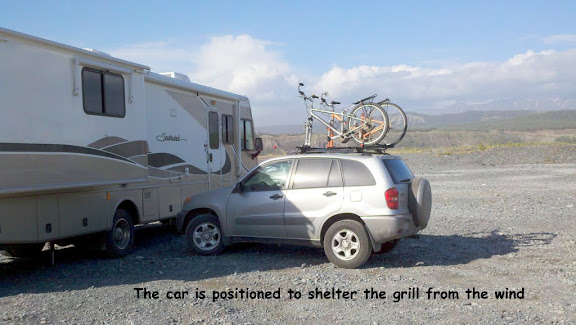


 After Top of the World it was a piece of cake. We had the bikes on the roof and I had brought along the seats and other paraphernalia necessary for bike riding. When we got to the end of the McCarthy Road we were confronted with a foot bridge and a half a mile walk beyond that to get to McCarthy, or hiring a shuttle from the other side of the footbridge. We got the bikes down and with much trepidation, put them together. We had not ridden them in several months (we actually can’t remember the last time we rode them), the chains are rusty and everything was a bit stiff. The tires were soft as well and I had not thought to bring my pump. That was good actually as the road was dirt and lent itself to underinflated tires.
After Top of the World it was a piece of cake. We had the bikes on the roof and I had brought along the seats and other paraphernalia necessary for bike riding. When we got to the end of the McCarthy Road we were confronted with a foot bridge and a half a mile walk beyond that to get to McCarthy, or hiring a shuttle from the other side of the footbridge. We got the bikes down and with much trepidation, put them together. We had not ridden them in several months (we actually can’t remember the last time we rode them), the chains are rusty and everything was a bit stiff. The tires were soft as well and I had not thought to bring my pump. That was good actually as the road was dirt and lent itself to underinflated tires.  and discovered there is not anything to do there before 5 PM, and it was not yet noon, except go on to Kennicott to tour the Kennecott Mine Mill and the Kennicott glacier. Those are not my misspellings. They meant to name the company after the glacier and misspelled it.
and discovered there is not anything to do there before 5 PM, and it was not yet noon, except go on to Kennicott to tour the Kennecott Mine Mill and the Kennicott glacier. Those are not my misspellings. They meant to name the company after the glacier and misspelled it. 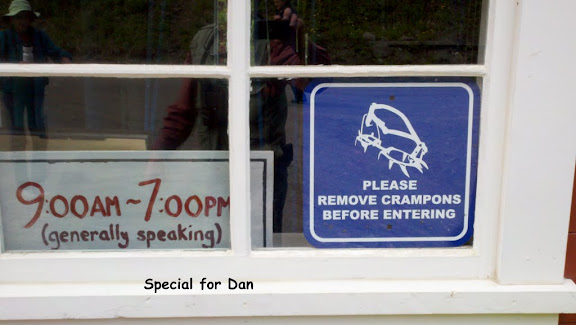 Here is the mill:
Here is the mill: Looking up at the 14 story structure from below knowing that it was built in 1908 we did not expect the tour to us take all the way through the remaining interior portions. We indeed climbed to the very top
Looking up at the 14 story structure from below knowing that it was built in 1908 we did not expect the tour to us take all the way through the remaining interior portions. We indeed climbed to the very top 
 where copper ore was received from the mines by tramway and followed the processing all the way to the very bottom where the finest poorest grade ore was sent to the leach plant for further extraction.
where copper ore was received from the mines by tramway and followed the processing all the way to the very bottom where the finest poorest grade ore was sent to the leach plant for further extraction. 
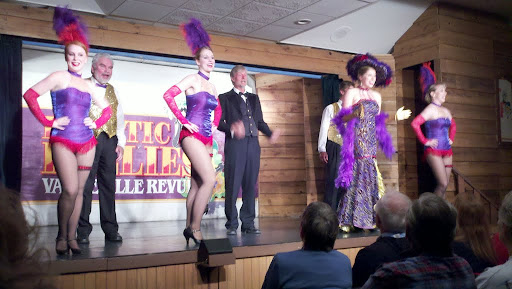
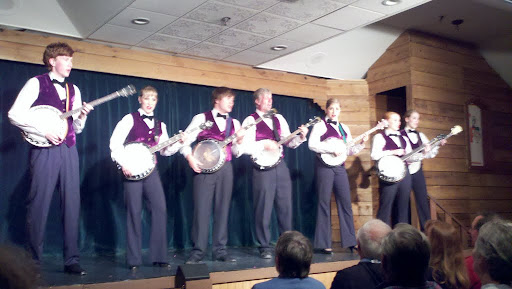 Got out at 10:15 and the sun was still up.
Got out at 10:15 and the sun was still up.

 From there we continued a bit south to Copper Moon Gallery. Watch for signs otherwise you would have a hard time finding it. It is an extensive gallery of local artists work. Although it is uneven, it does seem to feature some of the finest local art we have seen. This is well worth a stop, about 15 miles south of Whitehorse just north of the Petrogas station (within sight).
From there we continued a bit south to Copper Moon Gallery. Watch for signs otherwise you would have a hard time finding it. It is an extensive gallery of local artists work. Although it is uneven, it does seem to feature some of the finest local art we have seen. This is well worth a stop, about 15 miles south of Whitehorse just north of the Petrogas station (within sight).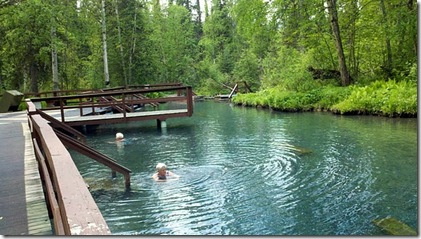
 bear and other critters along the road we eased in to Watson Lake, YT late afternoon and set up camp at Downtown RV. This was as described a large gravel parking lot with hookups and right in the center of town.
bear and other critters along the road we eased in to Watson Lake, YT late afternoon and set up camp at Downtown RV. This was as described a large gravel parking lot with hookups and right in the center of town. 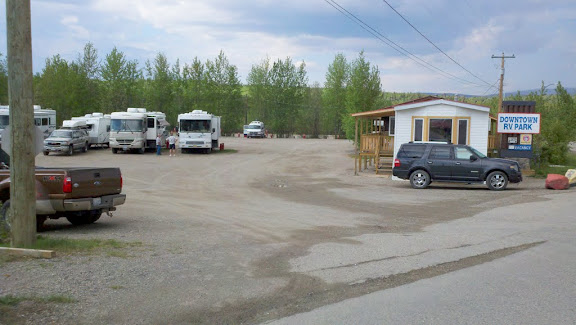 During the day’s drive we had noticed a clanging, banging noise which turned out to be a loose part on a rear wheel cover. Three of four rivets had come loose and the center section was wobbling and clattering. I spoke to the campground owner who directed me to the Home Hardware which was through the Signpost Forest and across the highway. There Homer guided me to the correct bin of nuts and bolts and advised me to add some Loktite to make sure they would hold. Returning to the campground I set up my repair shop – tool kit next to chair in the sun in front of the coach to make my repair. This attracted a neighbor who we joined later to see the Northern Lights Show. Yeah, I know we are in the Land of The Northern Lights, but they are hard to see when the sun has not set at 10 PM and rises before we awake at 4 AM. So we had to see the video of the Northern Lights in a very nice planetarium facility across the street form the campground.
During the day’s drive we had noticed a clanging, banging noise which turned out to be a loose part on a rear wheel cover. Three of four rivets had come loose and the center section was wobbling and clattering. I spoke to the campground owner who directed me to the Home Hardware which was through the Signpost Forest and across the highway. There Homer guided me to the correct bin of nuts and bolts and advised me to add some Loktite to make sure they would hold. Returning to the campground I set up my repair shop – tool kit next to chair in the sun in front of the coach to make my repair. This attracted a neighbor who we joined later to see the Northern Lights Show. Yeah, I know we are in the Land of The Northern Lights, but they are hard to see when the sun has not set at 10 PM and rises before we awake at 4 AM. So we had to see the video of the Northern Lights in a very nice planetarium facility across the street form the campground.
 It really isn’t technically desert as it is too humid. It is quite strange to see lush conifer stands in what appears on the surface to be desert and no cactus to be seen, they would never survive the sub zero (Fahrenheit) temperatures of winter. The town itself is torn up, as the roads are being realigned to make it easier for tour buses to drive through and stop. Also many of the important structures from times long gone are being restored. This is not a preserve area so major restoration is more a matter of money than permits. Walking around in some respects was like walking though a Disney back set before the place is ready for guests.
It really isn’t technically desert as it is too humid. It is quite strange to see lush conifer stands in what appears on the surface to be desert and no cactus to be seen, they would never survive the sub zero (Fahrenheit) temperatures of winter. The town itself is torn up, as the roads are being realigned to make it easier for tour buses to drive through and stop. Also many of the important structures from times long gone are being restored. This is not a preserve area so major restoration is more a matter of money than permits. Walking around in some respects was like walking though a Disney back set before the place is ready for guests. They were distracted enough that I was able to back the car up a 100 yards or so after going passed them and stop on the side of the road across from them and spend several minutes photographing for me and for Carol. We signaled to another car what we were seeing and as they stopped we drove on. The rest of the trip was engaged in much oohing and aahing over the incredible scenery and mountains still enrobed in snow and ice.
They were distracted enough that I was able to back the car up a 100 yards or so after going passed them and stop on the side of the road across from them and spend several minutes photographing for me and for Carol. We signaled to another car what we were seeing and as they stopped we drove on. The rest of the trip was engaged in much oohing and aahing over the incredible scenery and mountains still enrobed in snow and ice. We climbed past the Canadian customs, 7 miles from the border and ascended to the border with the US
We climbed past the Canadian customs, 7 miles from the border and ascended to the border with the US and then descended 7 miles or more to the US Customs Post. Those 14 miles are so inhospitable that no one wants to maintain a permanent post there. Oh yes, this is where the Gold Rush Stampedes of 1898 had to climb to to get to the Klondike Gold Fields in Dawson City. They had to travel 600, that’s six hundred miles from the ports of Skagway or Dyea.
and then descended 7 miles or more to the US Customs Post. Those 14 miles are so inhospitable that no one wants to maintain a permanent post there. Oh yes, this is where the Gold Rush Stampedes of 1898 had to climb to to get to the Klondike Gold Fields in Dawson City. They had to travel 600, that’s six hundred miles from the ports of Skagway or Dyea.  The largest warehouse is crumbling remains that need to be defended from the bears which like to tear the wood apart for the grubs that it hosts. The rows of trees planted to define the roads and a line of stumps.
The largest warehouse is crumbling remains that need to be defended from the bears which like to tear the wood apart for the grubs that it hosts. The rows of trees planted to define the roads and a line of stumps. 
